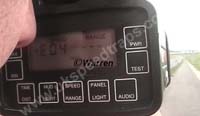Lidatek LE 30 Laser Jammer

Above: The New transponder
The new LE 30 is the latest Laser Jammer from Lidatek. The LE30 is the replacement to the LRC 100.
The LE 30 is still built in a high
quality aluminium case, epoxy sealed from the elements, very strong
and easy to mount with even more fitting options than the old
unit. It is supplied with one transponder, Status LED warning
diode, wiring loom with lots of cable and a speaker and now an
interface unit to link it all together. The whole package has
been thought about and is far neater and better presented. Cable
ties, screws, electrical joints, a bubble level and a quite good
and informative instructions. You should not need anything else.

Above: The LE 30 kit, brackets, screws, wiring, switch,
speaker, cable ties in fact everything you will
need straight out the box
It costs around £370 and if you plan
to do a front and back protection you could be looking at getting
up to three units. The owners manual does say that you
should use one transponder to cloak small to mid size vehicles,
motorbikes and vehicles with minimal front chrome. Two transponders
will be needed for large cars, light goods vehicles and HGV's.
Vehicles with excessive frontal chrome will also need two units.
Ask the dealer for advice on this matter. Up to
three additional transponders in total can be connected to the
interface unit, this is a cost option.
They are still using the gallium
arsenide laser-diode this is the same found in police laser guns
and is still the only laser jammer to use it, other jammers
often just use a lower cost diodes that can still do the job but
take more energy to do so and can suffer power fade over time.
The LE 30 detects the laser beam
from the police speedtrap and then fires back a laser signal in
the police signal this then prevents the laser gun's computer
from computing the speed reading.
Installing was easy. The
transponder contains a receiver/transmitter and should be mounted
level and vertically near the licence plate or in the grill opening,
it must have free view of the road in front, nothing should be
in the way. You get supplied a small bubble level to make sure
the head is in the correct orientation, this is very important
and your vehicle should be on a level surface when this is done. Aligning the transponder is the most important part of the fitting,
failure to align the transponder perpendicular to the line of
travel could allow the laser gun to get a reading.
The transponder is powered by the
signal/power wire with a simple waterproof connector, which plugs
in to the main wiring interface. The wiring loom is more than
long enough for even the largest of cars.
The brackets supplied give you all
sorts of fitting options and given the head is so small it is
very easy to find a discreet place to fit it. Take your time when
it comes to fitting the unit, play with different places before
you start making holes, decide what bracket or combination you
will use. The best place is in the centre of the car front both
horizontally and vertically and try to keep it near the number
plate.
Inside the vehicle you fit the on/off
switch, status LED, interface box and speaker, the switch can
go anywhere but try to get the status LED where you can see it.
The speaker makes around 110dba so
you can place it almost anywhere in a car but the LED and the
speaker are not much use on a bike, my motorbike tester for the
day pointed out that when you are riding the bike you have no
chance of hearing the speaker and the LED is hard to see.
Once fitted, you power it up with
the on/off switch, within few seconds seconds you get a notification
from the speaker and the warning LED that power is on (one beep/flash
per transponder) to say all is well with the transponder or transponders
and then the system goes into standby mode ready for jamming.
Just like the LRC 100 the unit can
only jam for a set length of time 5 seconds. Unlike the LRC 100
though the reset cycle takes 30 seconds after the jamming has
taken place to allow the Laser diode to cool down, you are told
that it is in recycle mode by an orange LED and after this it
will then re-enter standby mode and confirms this by two beeps
from the speaker.
The auto cut out feature works well,
it gives you enough time, 5 seconds, to adjust your speed during
jamming. It then turns off allowing the police officer to get
a speed reading after you have come down to the speed limit, other
systems often require you to turn off the jamming system with
a switch, this could be distracting.
Warning: Do not look directly
into laser aperture when the transponder is firing, yes I know
its hard when you are driving but if you are testing it with a
TV remote control its easy to look at the head.
So did it work......
?

Above: The test road
We tested the jammer on three vehicles, a Ford Fiesta,
Mitsubishi Shogun and R1 motorbike.
On the Ford Fiesta and the Mitsubishi Shogun the
transponder was mounted just under the front licence plate and
on the bike it is mounted above the wheel under the fairing.

Above: The
gun being jammed
Tests were done on our test road both the Ford Fiesta
and the R1 Motorbike were cloaked by the LE 30, even pointing
at the farthest points of the car from the jammer and the same
with the bike during jamming no speed could be obtained. The Mitsubishi
Shogun however was a slightly different story. This was a large
light and well chromed vehicle and it was not until we added another
LE 30 to the Grill above the number plate did we achieve cloaking
The LE 30 performs well and does what it says on
the box. BE aware that if you have a large vehicle you will have
to buy another transponder.
| What do we like. |
What don't we
like. |
- It's performance.
- Loud clear sounds in a car.
- Has Audio Mute
- Night Time Illumination control
- Size.
- Build quality.
- Instructions.
- Good choice of mounts.
- Warranty.
|
- Status LED fitted on bikes
is next to useless.
Bikers need something much brighter.
- Speaker, on a bike it's almost
pointless they need
another option.
|
|




